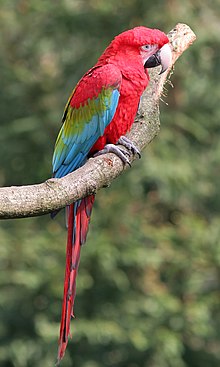Psittacofulvin

Psittacofulvin[pronunciation?] pigments, sometimes called psittacins,[1] are responsible for the bright-red, orange, and yellow colors specific to parrots.[2] In parrots, psittacofulvins are synthesized by a polyketide synthase enzyme that is expressed in growing feathers.[3] They consist of linear polyenes terminated by an aldehyde group.[4] There are five known psittacofulvin pigments - tetradecahexenal, hexadecaheptenal, octadecaoctenal and eicosanonenal, in addition to a fifth, currently-unidentified pigment found in the feathers of scarlet macaws.[5] Colorful feathers with high levels of psittacofulvin resist feather-degrading Bacillus licheniformis better than white ones.[6]

Both carotenoids and psittacofulvins have narrow-band absorbance spectra, reflecting pale yellow or red pigmentary colors, making them difficult to distinguish between using spectral measurements. However, there are differences between them when researched spectroscopically. The carotenoid and psittacofulvin yellows are very similar, but the red parrot pigment offers an advantage: it creates a more deep-red color when compared to astaxanthin, the pigment's counterpart in most other birds.
Birds have tetrachromatic vision, which means that they have four types of cone cells with peak sensitivities to longwave (l), mediumwave (m), shortwave (s), and ultraviolet (uv) or violet (v) light as well as transparent oil droplets made of carotenoid filters (with mainly the pigments galloxanthin, zeaxanthin, and astaxanthin) that refine spectral sensitivities of the l, m, and s cone-types.[7][8] These filters in front of the photoreceptors tune their spectral sensitivity to longer wavelengths. Birds have yet another spectral filter allowing them to absorb wavelengths in the far UV wavelength range.
References
[edit]- ^ Feinstein, Julie. "Where feather colors come from: Why cardinals are red and grackles are shiny". Birdwatching Daily. Retrieved 24 December 2020.
- ^ Masello, Juan F.; Lubjuhn, Thomas; Quillfeldt, Petra (November 2008). "Is the structural and psittacofulvin-based coloration of wild burrowing parrots Cyanoliseus patagonus condition dependent?". Journal of Avian Biology. 39 (6): 653–662. doi:10.1111/j.1600-048X.2008.04417.x.
- ^ Mundy, Nicholas I (February 5, 2018). "Colouration Genetics: Pretty Polymorphic Parrots". Current Biology. 28 (3): R113 – R114. Bibcode:2018CBio...28.R113M. doi:10.1016/j.cub.2017.12.045. PMID 29408256.
- ^ Stradi, R.; Pini, E.; Celentano, G. (2001). "The chemical structure of the pigments in Ara macao plumage". Comparative Biochemistry and Physiology Part B: Biochemistry and Molecular Biology. 130 (1): 57–63. doi:10.1016/s1096-4959(01)00402-x. PMID 11470444.
- ^ McGraw, Kevin J.; Nogare, Mary C. (15 February 2005). "Distribution of unique red feather pigments in parrots". Biology Letters. 1 (1): 38–43. doi:10.1098/rsbl.2004.0269. PMC 1629064. PMID 17148123.
- ^ Burtt, Edward H.; Schroeder, Max R.; Smith, Lauren A.; Sroka, Jenna E.; McGraw, Kevin J. (23 April 2011). "Colourful parrot feathers resist bacterial degradation". Biology Letters. 7 (2): 214–216. doi:10.1098/rsbl.2010.0716. PMC 3061162. PMID 20926430.
- ^ Tinbergen, Jan; Wilts, Bodo D.; Stavenga, Doekele G. (2013). "Spectral tuning of Amazon parrot feather coloration by psittacofulvin pigments and spongy structures". Journal of Experimental Biology. 216 (Pt 23): 4358–4364. doi:10.1242/jeb.091561. PMID 24031051.
- ^ Stoddard, Mary Caswell; Prum, Richard O. (September 2011). "How colorful are birds? Evolution of the avian plumage color gamut". Behavioral Ecology. 22 (5): 1042–1052. doi:10.1093/beheco/arr088. hdl:10.1093/beheco/arr088.
